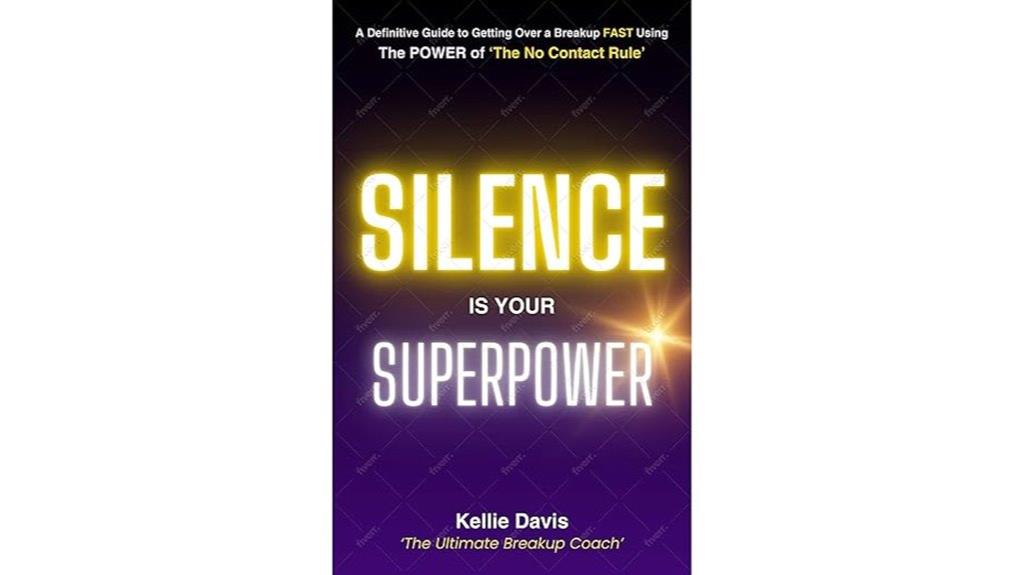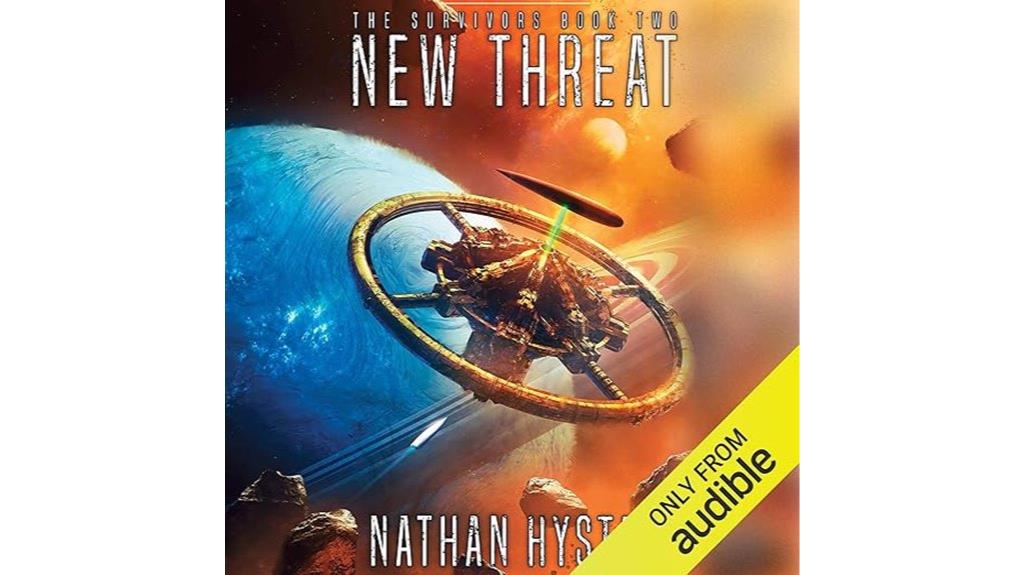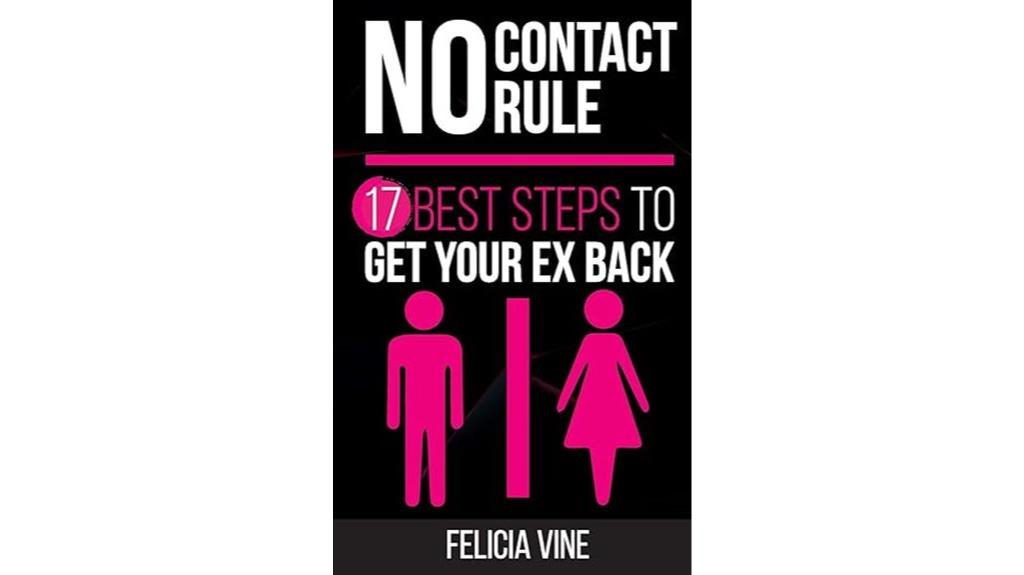If you’re looking to move on and heal, I recommend checking out the top six no-contact rule books that focus on emotional recovery and self-growth. These guides offer practical tips, step-by-step strategies, and motivational advice to help you regain confidence and set healthy boundaries. They emphasize patience, self-care, and internal reflection. If you want to understand which ones stand out and how they can support your journey, keep exploring—there’s more to uncover.
Key Takeaways
- The best books offer practical, step-by-step guidance for implementing the no-contact rule to promote emotional healing.
- Look for titles emphasizing self-care, patience, and internal growth to foster long-term resilience.
- Credible authors with personal experience or professional backgrounds provide more reliable and effective advice.
- Many top books incorporate real-life stories and actionable strategies to help manage contact and rebuild confidence.
- Fictional or thematic books (e.g., sci-fi) can offer unique perspectives on resilience and staying true to oneself during healing.
Silence is Your Superpower: Heal Your Heart FAST After a Breakup

If you’re looking to heal quickly after a breakup, “Silence is Your Superpower” is an ideal read for those who want practical, no-nonsense guidance on emotional recovery. I found this book incredibly helpful because it emphasizes self-care, embracing solitude, and understanding emotions. The author provides straightforward steps like prioritizing well-being, gaining self-awareness, and turning loneliness into self-discovery. It’s short, impactful, and easy to digest. Many readers, including myself, see it as a quick but powerful tool to rebuild confidence, regain personal power, and move forward. This book truly helps you turn heartbreak into growth.
Best For: individuals seeking quick, practical guidance to heal emotionally and rebuild confidence after a breakup.
Pros:
- Emphasizes self-care and embracing solitude for emotional growth
- Short, impactful, and easy to understand, making it accessible for immediate support
- Provides actionable steps to turn heartbreak into self-discovery and personal power
Cons:
- Some may find the advice too brief and in need of more in-depth exploration
- The book’s focus on quick healing might overlook deeper emotional complexities
- As a short read, it may not offer comprehensive strategies for long-term recovery
The Active No Contact Rule Book

The Active No Contact Rule Book stands out for readers who want straightforward, practical guidance on healing and rebuilding after a breakup. Clay Andrews’ conversational style makes complex emotional processes feel accessible, emphasizing self-awareness, patience, and genuine self-improvement. While some criticize the book for grammatical flaws and superficial advice, many find its detailed steps helpful for emotional recovery. The core idea is to focus on self-care, avoid contact, and show authentic change over time, which can influence reconciliation. Ultimately, it’s about healing from within and prioritizing self-worth, rather than playing mind games or chasing quick fixes.
Best For: individuals seeking straightforward, practical guidance on healing from breakup and rebuilding self-worth through authentic self-improvement and patience.
Pros:
- Clear, conversational style that makes complex emotional concepts accessible
- Emphasizes self-awareness, patience, and genuine change over quick fixes
- Offers detailed, actionable steps for emotional recovery and self-care
Cons:
- Criticized for grammatical errors and superficial advice
- Reliance on generic templates and repetitive content
- Some readers find the guidance oversimplified for complex emotional situations
New Threat

Looking for the best no-contact rule books to help you move on effectively? The “New Threat” in Nathan Hystad’s “Survivors” series introduces a world still grappling with alien dangers, societal flaws, and unresolved mysteries. As characters face cosmic battles and human prejudices, it’s a reminder that old fears and conflicts persist, even amid advanced technology and new worlds. If you’re healing from a breakup, understanding these ongoing struggles can mirror your own process of confronting lingering doubts and fears. This installment shows how resilience, wisdom, and staying true to yourself are essential, whether in space or in your personal life.
Best For: individuals seeking effective no-contact strategies to heal from heartbreak and move forward confidently.
Pros:
- Provides practical guidance rooted in emotional resilience and personal growth.
- Offers relatable insights that mirror overcoming societal and personal struggles.
- Encourages introspection and empowerment, fostering long-term healing.
Cons:
- May include language or themes that some readers find controversial or discomforting.
- Focuses on fictional space conflicts, which might feel disconnected from real-life breakups.
- Some advice might be more abstract, requiring additional effort to apply in personal situations.
No Contact Rule: 17 Tips on How to Get Your Ex Back

Anyone serious about rebuilding their relationship or gaining clarity after a breakup will find value in Felicia Vine’s tips on the No Contact Rule. Her 17 practical tips focus on understanding motivations, managing emotions, and fostering personal growth. Vine stresses the importance of self-reflection, setting boundaries, and giving yourself time without contact—usually around a month. She provides guidance on handling potential reconnection attempts, emphasizing calmness and rational responses. The goal isn’t just to get your ex back, but to make informed decisions based on emotional intelligence. While some find her advice straightforward, it offers a solid foundation for anyone seeking clarity, healing, or a second chance.
Best For: individuals seeking realistic, emotionally intelligent guidance on using the No Contact Rule to recover from a breakup or gain clarity.
Pros:
- Emphasizes self-reflection, emotional intelligence, and personal growth.
- Provides practical steps for managing contact and rebuilding or moving on.
- Focuses on realistic expectations and healthy decision-making post-breakup.
Cons:
- May lack depth and detailed strategies for complex or long-term no contact situations.
- Some readers find the advice too straightforward or brief for certain scenarios.
- Limited guidance for cases where the ex is completely unreachable or unresponsive.
Making Contact

If you’re interested in understanding how genuine connections are made and maintained, then “Making Contact” offers valuable insights into the world of SETI and the perseverance behind scientific discovery. Jill Tarter’s inspiring journey highlights the importance of resilience, dedication, and curiosity in pursuing the unknown. The book explores how scientists analyze signals, navigate funding challenges, and differentiate extraterrestrial signals from earthly noise. It’s a compelling story of pushing boundaries, overcoming obstacles, and inspiring future generations — especially women in STEM. Whether you’re curious about space or facing your own challenges, Tarter’s story reminds us that persistence is key to making meaningful contact, both in science and life.
Best For: science enthusiasts, students, educators, and anyone curious about extraterrestrial life and the pursuit of understanding our place in the universe.
Pros:
- Engaging and accessible biography that inspires curiosity and perseverance
- Highlights the scientific methods and challenges of SETI in an understandable way
- Celebrates the impact of women in STEM and encourages future generations
Cons:
- Lacks in-depth technical or scientific analysis of extraterrestrial phenomena
- Some sections may feel incomplete or have minor editorial issues
- Focuses more on biography and personal story than exploring broader extraterrestrial hypotheses
No Contact Rule: 14 Tips to Get Your Ex Back

The “No Contact Rule: 14 Tips to Get Your Ex Back” is perfect for anyone serious about rebuilding a relationship after a breakup. It emphasizes that avoiding contact initially gives both of you space to heal and reflect. Trying to persuade your ex to come back usually backfires; instead, focusing on self-improvement and emotional growth increases your chances. Patience is key—if your ex reaches out later, handle it thoughtfully. This approach can rekindle attraction and help you both reassess feelings. Following these tips, rooted in understanding emotional dynamics, can make a real difference in your journey to reconnect.
Best For: individuals seeking to rebuild a relationship after a breakup by focusing on self-improvement, patience, and strategic silence.
Pros:
- Encourages emotional healing and personal growth during the no contact period.
- Increases the likelihood of rekindling attraction and reuniting with an ex.
- Helps both parties reassess feelings and address underlying issues.
Cons:
- Can be difficult to resist the urge to contact the ex, requiring strong self-discipline.
- Success depends heavily on timing and emotional maturity, which varies per individual.
- May result in prolonged uncertainty or frustration if the ex does not initiate contact.
Factors to Consider When Choosing No-Contact Rule Books

When selecting a no-contact rule book, I consider the author’s credibility to guarantee solid advice. I also look for practical guidance that’s easy to follow and a clear writing style that keeps me engaged. Additionally, I prioritize books that focus on emotional understanding and offer in-depth content to truly help me through the process.
Author Credibility
Choosing a no-contact rule book with credible authors is essential to guarantee you’re getting reliable guidance. I look for authors with strong professional backgrounds, especially those with psychological expertise or personal experience in breakup recovery. Established authors who have published reputable books, articles, or research demonstrate their authority in emotional healing. I also consider reader reviews, testimonials, and endorsements from qualified professionals, as these add credibility. Practical guidance backed by evidence or success stories makes a book more trustworthy. Additionally, I check the author’s online presence—websites, social media, and multimedia content—to gauge their expertise and transparency. Ultimately, selecting a book authored by someone with verified credibility ensures you’re receiving advice rooted in proven knowledge and real understanding.
Practical Guidance
Practical guidance is the backbone of an effective no-contact rule book, providing clear, actionable steps to help you navigate this challenging period. A good guide offers step-by-step instructions on implementing the no-contact phase, emphasizing self-care, emotional distance, and patience. It should include strategies for handling initial contact attempts and maintaining firm boundaries. The most effective books ground their advice in psychological principles, like boosting self-esteem and resilience, to support your emotional well-being. Managing expectations is essential—understanding that consistency and genuine self-improvement are key to healing. Look for practical advice that’s realistic and easy to follow, helping you stay committed and focused on your growth. Practical guidance transforms a vague idea into a structured plan for moving forward.
Clarity & Style
The way a no-contact rule book is written can make a big difference in how effectively you follow through with your plan. I look for books that use clear, straightforward language, making complex breakup concepts easy to understand. An engaging style, whether conversational or relatable, keeps you interested and motivated. Well-organized formatting with headings and bullet points helps you quickly find key advice and stay on track. I avoid books packed with jargon or complicated vocabulary because simplicity makes the guidance accessible to everyone. A good style balances professionalism with empathy, offering emotional support while clearly explaining practical steps. Ultimately, I choose books that communicate ideas clearly, so I can confidently navigate my healing process without confusion or frustration.
Emotional Focus
When selecting a no-contact rule book, focusing on emotional content helps you prioritize your mental health and healing journey. I look for books that emphasize self-awareness, guiding me to understand my feelings during the breakup. These resources often provide strategies for managing intense emotions like grief, anger, or loneliness, which is vital for building mental resilience. I want a book that highlights internal growth and self-care as essential steps to rebuild confidence and self-worth. An emotionally focused approach encourages genuine self-reflection over manipulative tactics, ensuring my actions align with my authentic emotional needs. Prioritizing emotional content helps me stay grounded, fostering patience and emotional regulation as I navigate this difficult process.
Depth of Content
Choosing a no-contact rule book with the right depth of content can make a significant difference in how effectively I navigate my healing process. Some books offer detailed, step-by-step guidance, including emotional insights and practical exercises that help me understand and implement the rule confidently. Others are more superficial, covering only basic principles without exploring complex scenarios, which might leave gaps in my understanding. Generally, longer books tend to provide more exhaustive coverage, addressing common challenges and offering tailored advice. When selecting, I look for books that explain the psychological mechanisms behind no contact, so I can grasp why it works and stay motivated. The right depth ensures I get enough support and clarity to move forward with confidence.
Personal Stories
Personal stories in no-contact rule books can offer powerful insights because they showcase real experiences of people steering breakup recovery. Hearing about others’ emotional journeys makes the advice feel more relatable and tangible. These narratives often highlight both successes and setbacks, illustrating that progress isn’t always linear. They emphasize the importance of patience, self-awareness, and consistency when applying the no-contact strategy. Personal anecdotes also teach valuable lessons about setting boundaries, practicing self-care, and traversing the unpredictable nature of reconciliation efforts. Listening to others’ transformations can boost your confidence, showing that healing is possible in different relationship scenarios. Choosing a book with authentic stories allows you to connect emotionally and find motivation through shared experiences.
Additional Resources
Have you considered supplementing your reading with additional resources to deepen your understanding of the no-contact rule? Using tools like guided journals and online videos can markedly enhance your grasp and execution of no-contact strategies. Workbooks and online courses offer practical exercises that reinforce self-improvement during this period. Accessing content created by authors, such as YouTube videos or social media posts, provides ongoing motivation and support beyond the book. Joining online communities or forums allows you to share experiences, gain encouragement, and stay accountable. Combining these resources creates a well-rounded approach that addresses emotional, psychological, and practical challenges. This layered strategy can boost your confidence and resilience, ultimately helping you move on more effectively.
Frequently Asked Questions
Are No-Contact Books Suitable for All Types of Breakups?
No-contact books are generally helpful for most breakups, but they might not suit every situation. I’ve found they’re especially effective when you want to heal emotionally and regain control. However, if your breakup involves complex issues like abuse or ongoing conflicts, these books might not be enough on their own. I recommend evaluating your specific circumstances and possibly seeking additional support to ensure you’re truly moving forward and healing.
Can No-Contact Rule Books Help With Long-Distance Relationship Breakups?
Absolutely, no-contact rule books can be a lifeline after a long-distance breakup. They help you set boundaries, process emotions, and regain focus, even when miles apart. I’ve found that they act like a compass, guiding you through the storm. While distance complicates things, these books remind you it’s possible to heal and move on, turning the page to a new chapter with clarity and confidence.
How Long Should I Follow the No-Contact Rule According to These Books?
I typically follow the no-contact rule for at least 30 days, as recommended by many of these books. However, some suggest extending it to 45 or even 60 days if I need more time to heal. I believe the key is listening to my emotions; if I still feel hurt or tempted to reach out, I give myself more time. Ultimately, it’s about giving myself space to recover.
Do These Books Address Healing From Emotional Abuse?
Think of emotional abuse as a storm that leaves behind scars in your mind and heart. These books do address healing from such trauma, guiding you through the aftermath and helping you rebuild your inner peace. They offer tools to recognize abuse, set boundaries, and restore your confidence. I found their insights invaluable, helping me navigate the storm’s wreckage and find calm again.
Are There Specific Books for Healing After Divorce or Only Breakups?
There are definitely books tailored specifically for healing after divorce. I’ve found that these books focus on maneuvering the legal, emotional, and practical aspects of ending a marriage. They offer guidance on rebuilding your life, finding closure, and rediscovering yourself. While some general breakup books help, divorce-specific ones provide deeper insights into the complex emotions and challenges unique to that experience, making them especially helpful for healing and moving forward.
Conclusion
If you’re serious about moving on, these books are like a map through a dense forest—guiding you safely to healing. Each one offers unique tools, whether you need to silence your heart or reconnect thoughtfully. Remember, healing is a journey, not a race. Stick with it, stay committed, and you’ll find your way out stronger, just like a phoenix rising from the ashes. You’ve got this—your brighter future is waiting.









